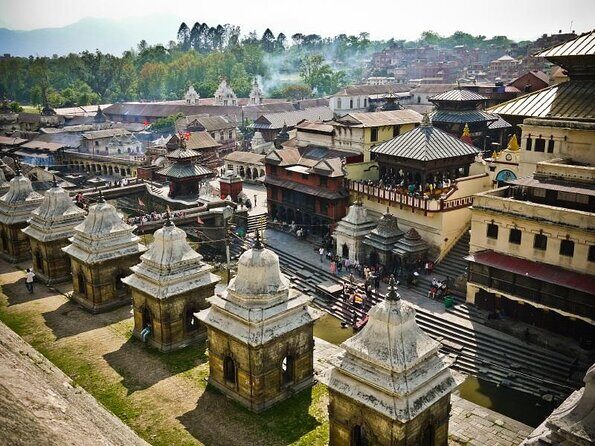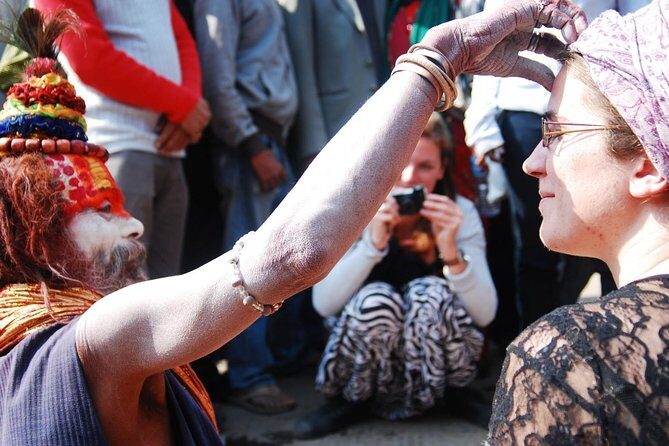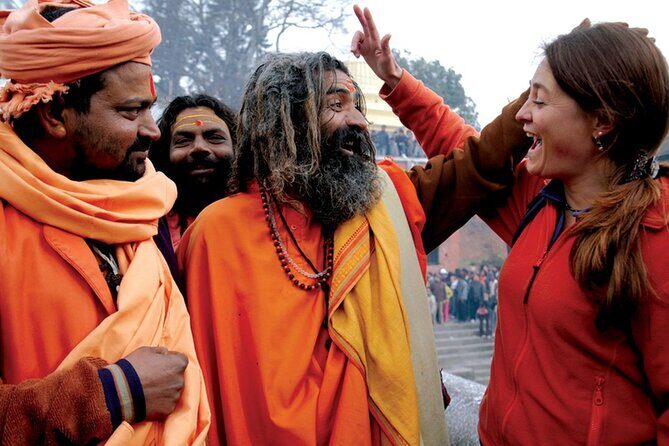Kathmandu’s spiritual sites come alive at sunset, and this tour offers a balanced, inside look at two UNESCO World Heritage landmarks: the Pashupatinath Temple and Bodhnath Stupa. For just over four hours, you’ll encounter vibrant rituals, locals in prayer, and the unique atmosphere that makes Kathmandu a hub of religious devotion. Guided by knowledgeable locals like Rozit, you get more than just sightseeing — you observe daily religious practices, meet sadhus, and even peek into the lives of mourners along the Bagmati River.
What makes this experience particularly rewarding? First, the chance to participate in the mesmerizing Aarati ritual at Pashupatinath, where hundreds gather in the evening to light butter lamps, creating an unforgettable scene. Second, traveling on public transport adds an authentic flavor, giving you a glimpse of local life beyond the tourist spots. It’s a guided journey that balances cultural depth with personal storytelling — ideal for curious travelers eager to understand Nepal’s spiritual fabric.
A caveat? The cremation ceremonies along the Bagmati River are a solemn part of the experience, and photography is discouraged there — a reminder to approach with respect. Also, while the tour is generally praised for its inclusiveness, keep in mind that site conditions may have changed after the 2015 earthquakes, which means some areas have been repaired but may not look exactly as they once did.
This tour suits travelers who want a meaningful introduction to Kathmandu’s religious life, enjoy a mix of history, architecture, and local insights, and are comfortable walking and navigating bustling markets and crowds.
Key Points

- Authentic Experience: Travel by local transport for a genuine feel of Kathmandu’s streets.
- Cultural Depth: Learn about Hindu and Buddhist traditions with a knowledgeable guide.
- Stunning Rituals: Witness the Aarati and observe cremation ceremonies with respect.
- Small Group: Limited to 12 people, ensuring personalized attention and interaction.
- Flexible & Value-Driven: All entrance fees to UNESCO sites included, making for a seamless experience.
- Impact: The tour supports local communities and cultural preservation through site fees and optional offerings.
A Full Look at the Pashupatinath and Bodhnath Tour
Planning more time in Kathmandu? We've covered other experiences worth considering.
Why This Tour Excels in Offering a Genuine Glimpse of Kathmandu
This guided evening excursion from Kathmandu acts as a wonderful introduction to the city’s spiritual heartbeat. It’s designed not just to show you the sights but to help you understand what they mean to locals. Traversing from Thamel, the tourist hub, to two of Nepal’s most revered UNESCO sites, you’re led through a world of prayer wheels, sacred chants, and vibrant rituals.
Price-wise, at just over $60 per person, this tour offers great value considering its inclusivity—covering entrance fees, transport, and expert guidance. Plus, it’s booked on average 39 days in advance, showing strong demand among travelers wanting a reliable, well-organized experience. The small-group setup (or private option) means you get plenty of attention, tailored insights, and fewer crowds.
The Itinerary: From Boudhanath to Pashupatinath
Boudhanath Stupa: A Tibetan Buddhist Icon
The tour begins at Boudhanath Stupa, a place that feels both monumental and intimate. This enormous white dome, encircled by prayer wheels, has served as a spiritual focal point for centuries. As you rotate the wheels with locals, you’ll get a sense of the community’s devotion. Lighting a butter lamp and watching the prayer flags flutter creates a serene, almost meditative atmosphere.
Many reviews highlight how much visitors appreciate the opportunity to participate actively in the prayers and rituals. One traveler mentioned, “I enjoyed lighting a butter lamp and seeing the locals’ devotion firsthand,” emphasizing how the site remains deeply meaningful for pilgrims and travelers alike.
Thamel: The Heart of Kathmandu’s Vibe
A quick 15-minute drive from Thamel takes you to Boudhanath. This vibrant neighborhood is a hub of cafes, shops, and Tibetan culture. It’s a great spot to soak in local life before heading to the more intense spiritual practices at Pashupatinath.
Pashupatinath Temple: The Hindu Sacred Site
Next, you’ll walk for about 15 minutes to Pashupatinath Temple, a sprawling complex that dates back to the 17th century. Dedicated to Lord Shiva, it’s one of the holiest Hindu shrines in the world. The atmosphere here is both majestic and lively, with sadhus (holy men) dressed in vivid robes and ash-smeared faces performing rituals.
Your guide will offer insights into Hindu beliefs, especially the ideas surrounding the cycle of birth and death — concepts that are vividly reflected in the temple’s everyday life. One quote from a traveler captures the vibe: “Watching the sadhu monks and their devotion was unforgettable.”
The Cremation Rituals along the Bagmati River
Outside the main temple, along the riverbank, witnessed cremations are a sobering, real-world aspect of Hindu practice. Out of respect, photography is discouraged, but the sight of families mourning and monks performing final rites gives a profound sense of life’s transient nature.
The Evening Aarati at Pashupatinath
As the sun sets, the crowd swells for the Aarati, a ritual where priests offer lights to Shiva. The flickering butter lamps, combined with the rhythmic ringing of bells, create a deeply emotional scene. Many reviews praise this part of the tour: “The aarti ritual was mesmerizing and truly moving,” says one guest.
The Experience and Guides
The tour is led by local guides like Rozit, who guests describe as knowledgeable, personable, and caring. Several reviews mention how guides like Amit and Bipin go above and beyond by sharing stories, taking photos, and answering questions — making the experience feel like visiting with a knowledgeable friend.
With a maximum group size of 12, you won’t be lost in a crowd, and the small group allows for meaningful interactions. Guests consistently note the value of having a guide to explain the complex religious symbolism and cultural practices they see.
Transportation and Timing
Traveling by public transport is a highlight for many, offering a slice of everyday life. The tour starts at 3 pm from Hotel Marshyangdi in Thamel, giving plenty of time to enjoy the sites as they come alive at dusk. The entire experience ends back at the starting point, making logistics straightforward.
In total, expect about 2 km of walking, mostly between sites and along the riverbanks. While some may find the pace leisurely, prepare for the crowds and the lively atmosphere, especially during the evening rituals.
Pricing and Value
At just over $60, the tour includes entrance fees to both UNESCO sites and transportation. The value lies in the guided insight, local transport, and the chance to witness rituals not easily accessible on your own. The optional experiences, like palm reading or offering butter lamps, are extra but support local artisans and spiritual practitioners.
What Past Travelers Say
The reviews are overwhelmingly positive, with many describing the guides as “excellent,” “knowledgeable,” and “friendly.” Comments like “it felt like hanging out with a local friend” underscore how personal and authentic this experience is. Several highlight how the tour makes complex religious practices understandable and relatable.
One challenge mentioned was the potential for crowds, which is inevitable at such popular sites. Still, many find that the guides navigate the busy streets effectively, and the intimate group size makes it manageable.
Who Should Take This Tour?

This experience is great for curious travelers eager to understand the spiritual fabric of Kathmandu beyond just sightseeing. It’s suitable for those comfortable walking, navigating crowds, and participating in local rituals. Family travelers, especially with children under 6, will find it accessible since it’s child-friendly and well-organized.
If you’re interested in religion, culture, and authentic local practices, and are happy to spend an evening exploring in a small group, this tour offers impressive value and memorable sights.
FAQ

- How long is the tour?
Around 4 hours, starting at 3 pm and ending back at the starting point. - What sites are visited?
The tour visits Boudhanath Stupa, Pashupatinath Temple, and the cremation sites along the Bagmati River. - Is transportation included?
Yes, the tour covers the costs of public transport between locations. - Can I join with children?
Yes, it’s child-friendly. Children under 6 join free, making it accessible for families. - What should I wear?
Respectful clothing covering shoulders and knees is recommended, especially at religious sites. - Are there optional expenses?
Palm reading and offerings like butter lamps are optional and paid separately. - Is photography allowed at all sites?
Photography is discouraged during cremation ceremonies out of respect, but generally permitted at other locations. - How many people typically join the tour?
The small group size caps at 12, ensuring personalized attention. - What if I need to cancel?
Cancellations are free if made at least 24 hours in advance.
To sum it up, this tour offers a beautifully balanced mix of history, spirituality, and local life. Guided by friendly, knowledgeable locals, you’ll get an authentic taste of Kathmandu’s religious traditions. Whether you’re a history buff, a spiritual seeker, or simply curious about Nepalese culture, this experience promises meaningful encounters, stunning sights, and a deeper understanding of what makes Kathmandu tick. It’s a well-priced adventure that rewards those willing to step into the bustling, sacred world along the Bagmati River and beyond.
More Tours in Kathmandu
- Kathmandu: Private Patan and Bhaktapur Sightseeing Tour
- Full Day Private Tour of Seven World Heritage Sites in Kathmandu
- Walking Tour of Kathmandu (Half Day)
- Kathmandu Valley Full Day Sightseeing Tour
- Kathmandu: Full Day 7 UNESCO Tour with Lunch – Private/Group
- Kathmandu: Local Market Tour with Optional Lunch/Dinner
More Tour Reviews in Kathmandu
More Kathmandu experiences we've covered
- Private 8 – Day Langtang Trekking
- Kathmandu: Private Patan and Bhaktapur Sightseeing Tour
- Full Day Private Tour of Seven World Heritage Sites in Kathmandu
- Walking Tour of Kathmandu (Half Day)
- Everest Three Pass Trek
- Nagarkot Everest Sunrise, Hike to Changunarayan & Bhaktapur
- Langtang Valley Trek
- Historical Kathmandu
- Kathmandu Valley Full Day Sightseeing Tour
- Nagarkot Sunrise View & Day Hike to Changunarayan from Kathmandu
- Cremation Rites in Kathmandu
- Everest Experience Mountain Flight
